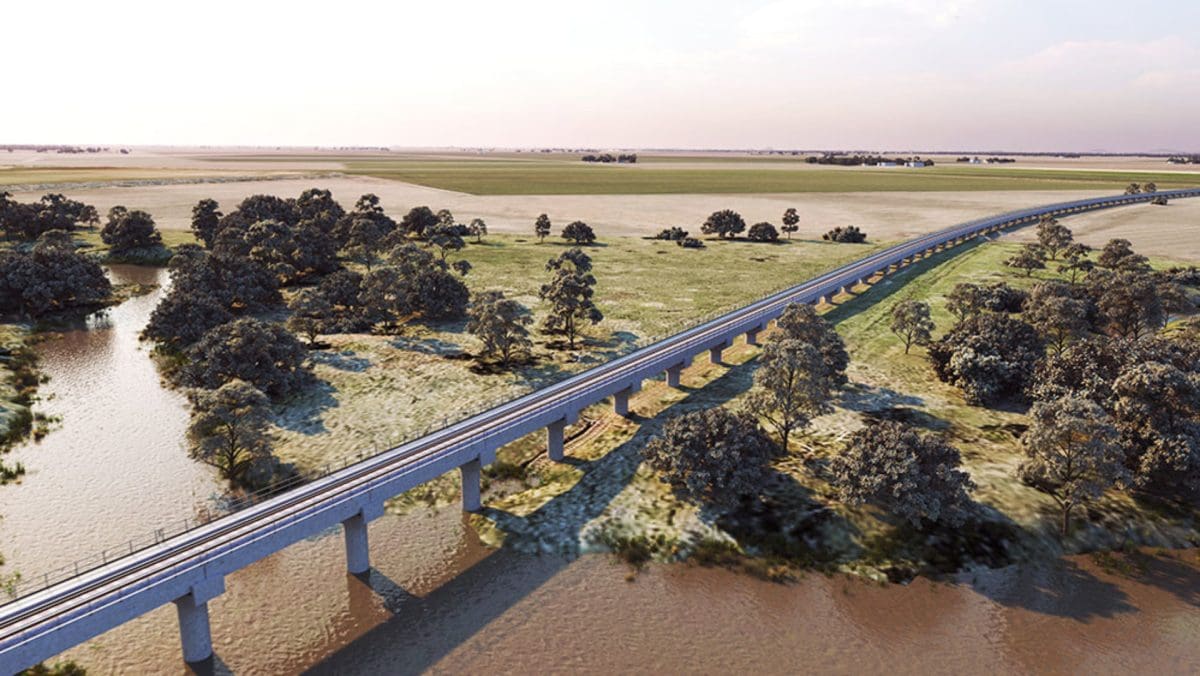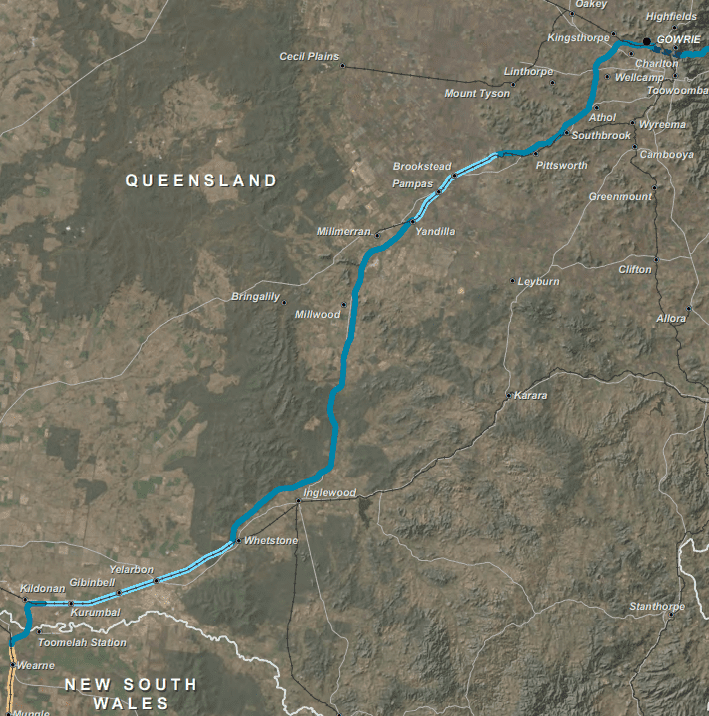
Visualisation of the proposed Condamine River floodplain crossing. Photo: ARTC
A GROUP Darling Downs farmers are urging the Federal and Queensland governments to abandon the controversial Border to Gowrie (B2G) route of the Inland Rail, with the project stalled due to questions over the draft Environmental Impact Statement.
The current B2G route includes 138km of new dual-gauge track and upgrades to 69km of existing lines running from the New South Wales-Queensland border near the townships of Inglewood, Millmerran and Pittsworth and ending at Gowrie Junction, north-west of Toowoomba.
It travels through highly productive agricultural regions that produce summer and winter crops and is the location of several major feedlots and cattle-grazing operations.
The route has come under criticism since the preferred alignment was announced as the rail line will cross the Condamine Floodplain, which some growers believe will cause increase flooding risks.
In addition to delays due to the EIS, the section is also being hampered by a Federal Government review into the entire Inland Rail project which was announced in October and is due to be released this year.
The Australian Rail Track Corporation, the company overseeing the project, is also considering recommendations from an independent report into flood studies for the Queensland route.
These three enquiries have served to stall construction on the route, which had an original completion date in 2026.
This has also forced the Queensland Government’s Coordinator-General to grant several extensions for the project to allow it to progress assessment, with the last approved in December.
The project now has until March 2024 to finalise the EIS and receive final development approvals.
Communities await updated EIS
The draft EIS was released for public consultation in January 2021.
The document is a vital step in a project’s approval process and considers the environmental, social and economic impacts of any new development.
In December 2021, the Coordinator-General – after reviewing submissions – pushed the report back to ARTC, seeking more information on topics, such as, noise and vibration traffic and transport, stakeholder engagement, environmental values flooding, groundwater, economics, social impact and air quality.
The new information will form part of a revised draft EIS, which will be released for a further public consultation period when completed.
At over 12 months since this decision, Darling Downs lobby organisation, Millmerran Rail Group (MRG), believes now is the time to change the route to another alignment which they believe would have a reduced impact on farmers.
MRG chairman and Millmerran farmer, Wes Judd, said affected communities were frustrated by the delays.
“It is a complete joke and prolongs the agony for families, farmers and businesses impacted by the current proposals,” Mr Judd said in a statement.
“Rather than extend the anxiety of so many farming families and residents in the Millmerran district, ARTC should allow this route to lapse.”
Mr Judd said this will most likely be further prolonged if the revised draft EIS needs additional work before being approved.
Alongside complaints from community members, the Toowoomba Regional Council also knocked back the draft EIS, citing concerns around management of flood mitigation and road-traffic requirements.
He said with the EIS stalled and the government awaiting results of a review into the Inland Rail project, the route could be changed now without the need to rip up rail lines.
“While the Albanese Government has commissioned Dr Kerry Schott AO to undertake a review of Inland Rail, the decision should be made by ARTC to not seek another extension for its flawed route and start working on developing within the existing corridor.”
An ARTC spokesperson confirmed that the organisation is “now preparing” additional information for the Coordinator-General following the request for more information.
“This request is a normal step in the assessment process for a major coordinated project and ARTC is working closely with the Queensland Government on ensuring the matters raised in public submissions are being responded to,” the spokesperson said.
“The revised draft EIS will be subject to a further period of public consultation providing all stakeholders with an opportunity to consider ARTC’s responses to their submissions and further comment on the project.
“The timing of this period of public consultation will be determined by the Coordinator General following submission and acceptance of ARTC’s revised draft EIS.”

Map of the proposed Border to Gowrie alignment. Source: ARTC
ARTC considers flood review
A key concern for residents, farmers and local government is how the B2G alignment will mitigate any possible flooding impacts neighbouring communities and farmland.
A report from Independent International Panel of Experts for Flood Studies of Inland Rail in Queensland, released in October, considered these issues and the work done by ARTC.
The panel recommended that ARTC consider and review data from 2021-22 flood events, undertake a geomorphic risk assessment and ensure updated modelling is included in an updated EIS.
As part of Senate Estimates session in October, Major Transport and Infrastructure Projects (a division of Department of Infrastructure, Transport, Regional Development, Communications and the Arts) first assistant secretary Jessica Hall said the expectation is that the recommendations will be implemented by ARTC.
“The shareholder ministers have now written to ARTC, making it very clear that it is their expectation that any of the recommendations that come out of the flood panel are implemented as part of all of the future design processes,” Ms Hall said.
“ARTC is now working with the Queensland Government to make sure they have a proper assurance process in place to ensure that happens.”
B2G alignment’s long history
B2G alignment options were first considered in 2016-17 and found the proposed route through Millmerran was the best available.
A further review of two alternative options was also undertaken in 2020, with no route changes recommended as a result.
An ARTC spokesperson said the current alignment is the culmination of years of work by the company and engineering experts to ensure the project is constructed in a way that is safe and suited to its environment.
“During this period, we’ve conducted extensive field studies, detailed environmental investigations and extensive consultation with communities and landholders.
“ARTC has tried from the outset to minimise impacts on landowners and the environment, deliver a value-for-money project for taxpayers and design the best rail line we could.
“This analysis has been guided by the Australian Government in consultation with state governments and the freight and logistics sectors.”
Grain Central: Get our free news straight to your inbox – Click here

HAVE YOUR SAY